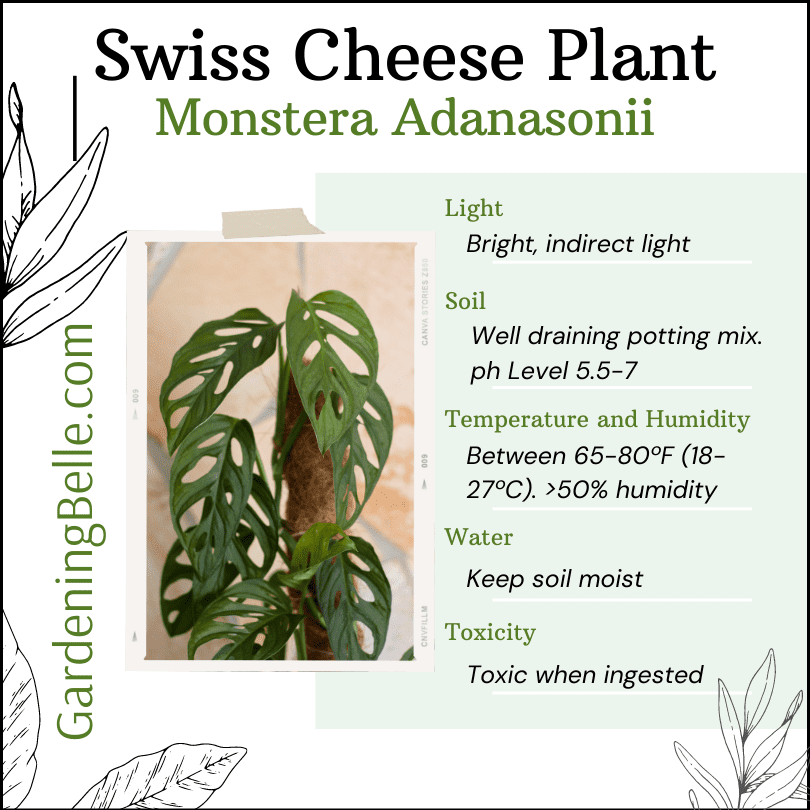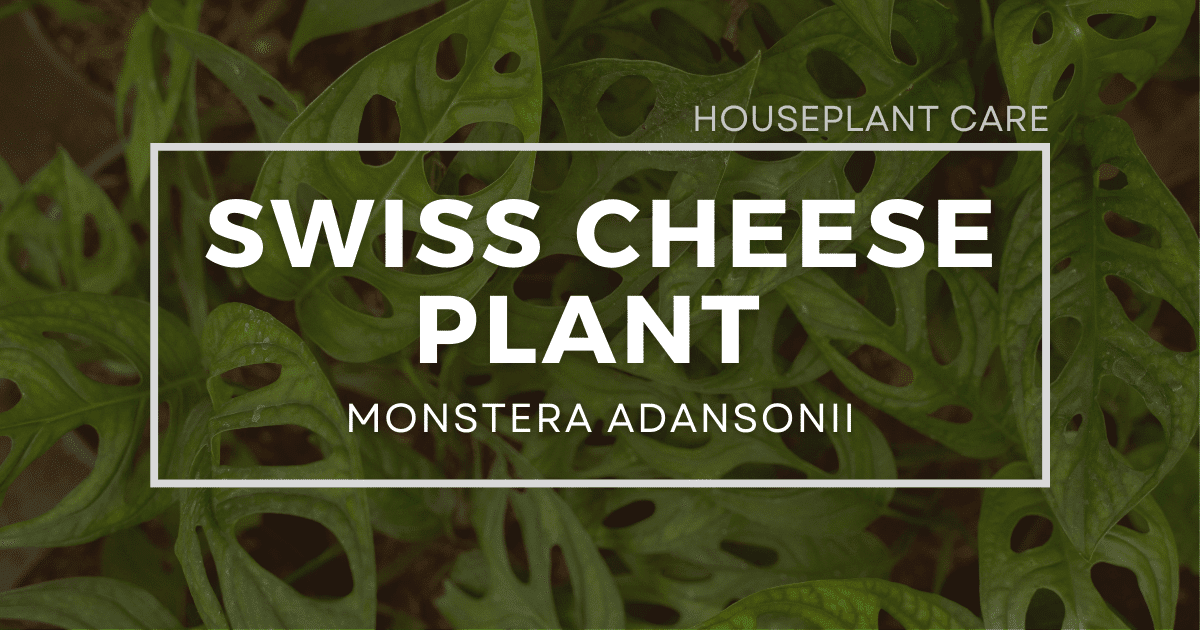The Swiss Cheese Plant, specifically the Monstera Adansonii, has interesting-looking foliage with its irregular, distinctive oval-shaped holes which is probably one of the main reasons it has become a standard collector’s houseplant.
The plant has a fast growth rate and a vining habit. Once they have established, they can reach up to 12 feet or more even indoors when given the right conditions. For this climbing shrub to grow larger leaves (known as adult leaves) it would be better to have it supported in a stake. However, this easy going plant can be hang with its perforated foliage cascading down.
A healthy Swiss cheese plant will have deep green waxy leaves with no discolorations. To maintain this, it needs to be in warm and humid conditions with bright indirect light.
However, if you decide to get one do take note that the plant contains insoluble calcium oxalate crystals which are toxic to small animals such as cats and dogs when ingested. Even though it’s not fatal it’s better to be aware.
Other nicknames: Swiss Cheese Vine, Five holes plant, Adanson’s monstera, Monstera monkey mask
Swiss Cheese Plant Care Summary
- Bright, indirect light is ideal
- Keep the soil moist but not soaked.
- Water when the top of the soil is almost completely dry
- Aim for temperatures between 65-80ºF (18-27ºC)
- Mist leaves occasionally and keeps them free of dust
- Use a moss pole to get the leaves to grow larger

Light Requirement
When it comes to the Swiss cheese plant light requirement it would be best to consider where it came from. In its natural habitat, this plant thrives under the cover of large trees. It would then be best to give it bright indirect light. This means a spot with tons of bright light but far enough away so that its leaves do not receive the full strength of direct sunlight. Direct sun exposure will be too harsh and burn its foliage. It might be able to tolerate 2 to 3 hours of the direct morning sun at most anything more and you run the risk of scorching its foliage.
On the other hand, if it’s left in a low-light space, the plant might become leggy as it search for some light source. The vines will be long, but has very few leaves. If monstera plants are kept in prolonged low light, leaf fenestration might not occur.
Soil Requirement
For most house plants well-draining soil is of high importance. This is true for the Swiss Cheese Plant as well. Though it enjoys moist soil, soaking in one is not appreciated. Choose a potting mix that will help trap moisture without being waterlogged. Moisture-retaining, but well-draining soil mix. Make sure that your container has a drainage hole to let water out and avoid it from standing in water. Soil that stays wet can be detrimental to the plant with the possibility of root rot as well as breeding bacteria and pests. Ideal pH level 5.5-7
Note: Grows best in a well-draining Aroid mix using bark, perlite/pumice, peat moss/coco coir, and charcoal.
Watering Requirement
The trickiest requirement in houseplant care is watering. To keep the plant happy the potting mix needs to remain slightly moist but not soggy. As with any plants in a container, water only when the top 1 inch or more of the soil is dry. If you’re feeling fancy, you can get a moisture meter that can be stuck into the soil to check if it’s dry. Or if you want to get down and dirty, stick your fingers in to check the soil. Water 1-2 times per week during the sunny season – less in the cold season. Keep the soil moist.
Temperature and Humidity
Being native to Central and South America they thrive in warm temperatures. The plant would be happy when in an area that mimics its natural habitat, the ideal temperature is between 65-80ºF (18-27ºC) although they can survive cold temperatures don’t expect any growth. As with all species in the monstera genus, this plant will benefit from higher humidity levels. Increasing humidity does wonder to its foliage. A humidity level above 50 percent is ideal.
Fertilizer
To keep houseplants healthy, it needs to be fed during their growing period. However, a freshly potted plant won’t need additional fertilizer for 4-5 months as the standard potting mix already includes fertilizers. To aid during its growing season and avoid yellowing leaves use an all-purpose fertilizer, diluted by half, monthly.
Pruning and Training
As this is a vining plant whether you stake it to climb or let it flow down it might outgrow your space and a little snip might be required. Pruning is not only to help control the growth of the vine but also to direct the plant’s focus on growing its healthier leaves which will make the plant stronger. Always use sterilized pruning shears to cut back the stems but note not to cut more than 25 percent pruning. Make the cut just above a leaf node. Also, remove any dead, damaged leaves or stems that are growing in the undesired direction. Don’t throw away your cuttings as they can be propagated into a new plant.
Propagation
Monstera adansonii propagation is relatively easy. Take some cuttings that have at least two nodes (the knobs in between leaves) and set them in a glass with water. Place it in a location with bright indirect light. Change the water at least once a week and refill if the water level depletes. Once the vine has developed a root of at least two or three inches you can now plant it in soil. For the first few weeks keep the soil moist, as the cutting has been growing in water for its growing duration it’ll take some time to adjust to being in soil. Another option is placing the cutting directly into the soil to root. It will take at least a few weeks for the root system to develop and for any new growth to sprout. Be patient and you’ll have a new plant.
Common Pests and diseases
The Swiss cheese plant is prone to a variety of common houseplant pests and bugs such as spider mites, mealy bugs, aphids, thrip, scale, and whitefly. Though infestations can cause inconvenience luckily, it’s rarely fatal. It can be mitigated and treated using a mix of neem oil, rubbing alcohol, and castile or diluted dish soap. Regularly inspect each leaf especially the underside for potential hidden pests. The best way to prevent infestation is to keep the plant healthy as possible. Another issue to be aware of are root rot which is a result of overwatering.
Final Thoughts
As with most epiphyte plants care for Swiss Cheese Plant is easy. With the right conditions hopefully, we’ll be seeing an insta-worthy photo op ready plant all the time.


